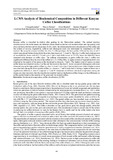| dc.description.abstract | Kenyan coffee is classified by defects after grading by the ‘Devonshire method.’ The method involves
classification of the coffee beans into different classes based on the raw and roasted coffees and cup quality, with
class one being the best and ten the poorest. In this study, the relationship between classification of the coffee and
the content of sucrose, trigonelline, caffeine and chlorogenic acids was determined by simultaneous LC-MS
analysis. By using the sensory variables the class 3 coffee portrayed the best quality, followed by class 4 and 5
which were placed further distinctively from the other classes (6, 7, 8 and 9). The class 3 coffee had a high percent
of non-defective beans with 94.31% and class 9 had a high defect count at 79.53% hence the defective beans
increased with decrease in coffee class. The caffeine concentration in green coffee for class 3 coffee was
significantly different from the rest of the coffees at 1.23 ± 0.00g/100g. A higher content of trigonelline levels was
observed as the quality of the green coffee decreased in classes 6, 7 and 8. The highest level of sucrose in green
coffee beans was observed in class 3 coffee and the lowest in the class 9. Lower content of chlorogenic acids were
observed among the high quality coffees i.e. class 3, 4 and 5 with class 3 having the lowest while a higher content
was observed among the lower quality coffees i.e. classes 6, 7 and 9 with class 6 having a higher content was it
significantly different in class 6 compared to 7 and 9?. Quantities of different chemical components among the
classes are clear indicators that the classification method used on the Kenyan coffees brings out the differences in
coffee quality based on the analysis of the green and the roasted coffees. | en_US |

